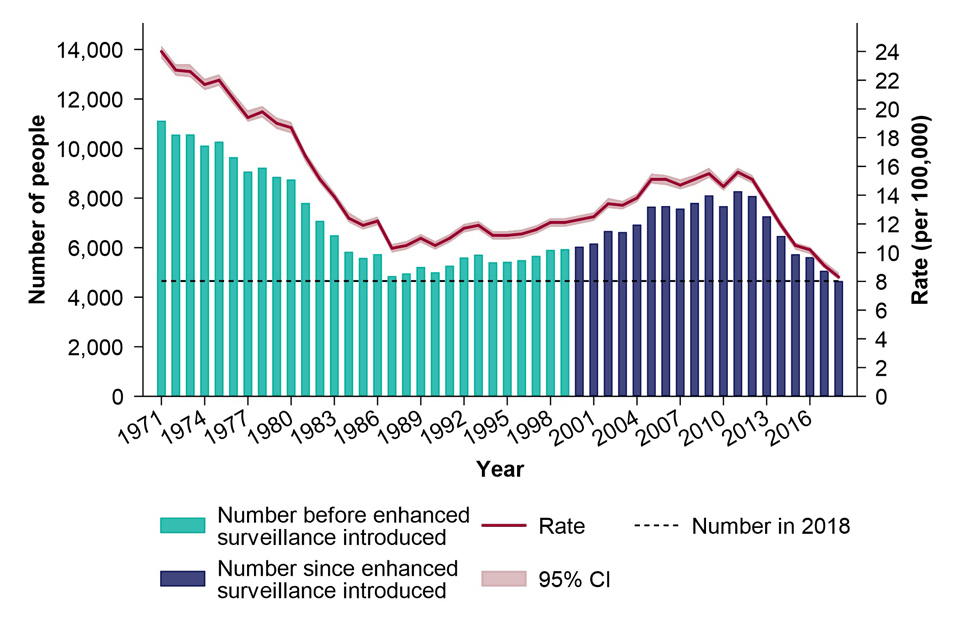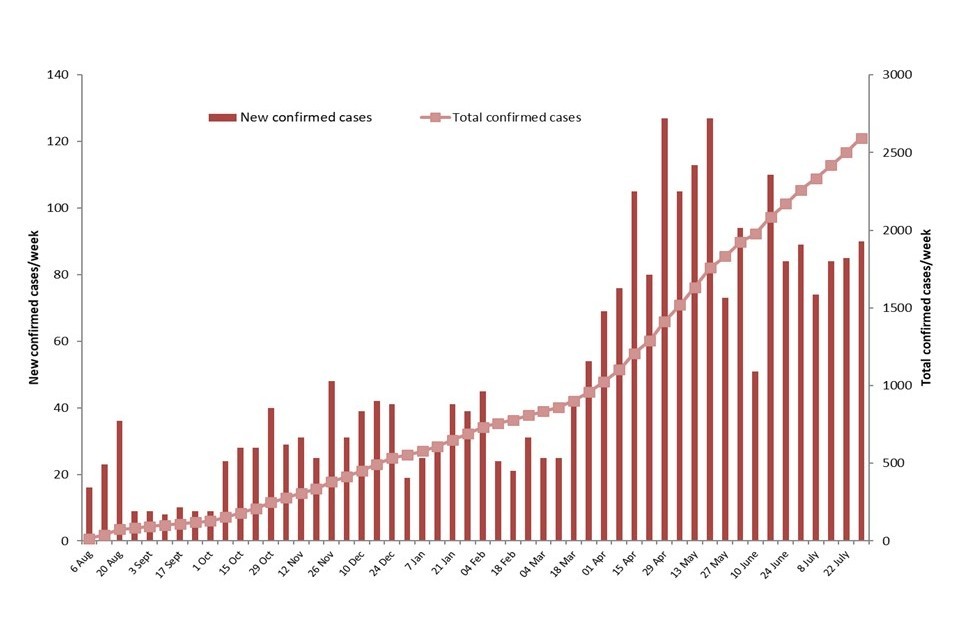HPR volume 13 issue 27: news (2 and 5 August)
Updated 20 December 2019
Tuberculosis in England: 2019 report
Public Health England (PHE) has published its annual tuberculosis (TB) report for England [1] containing data to the end of 2018. The report also presents data on the UK pre-entry screening programme as well as latent TB infection (LTBI) testing and treatment.
The TB report has been released almost 2 months earlier than in previous years and, together with the accompanying monitoring indicator data displayed on Fingertips (released on 6 August 2019), will support timely actions to achieve the aims set out by the Collaborative Tuberculosis Strategy for England 2015 to 2020.
Epidemiology
There were 4,655 people diagnosed with TB in England in 2018, an 8.2% decline from the previous year. The rate of TB reached an all-time low of 8.3 per 100,000 population and has now been below the 10 per 100,000 World Health Organization (WHO) definition of a low incidence country since 2017 (see figure).

Number of TB notifications and rates, England, 1971 to 2018
People born outside the UK continued to account for the most notifications in 2018 (72%) and, with a TB incidence rate of 39.0 per 100,000, remained 14 times greater than the rate among people born in the UK (2.8 per 100,000). Between 2017 and 2018 there has been a decline in the number and rates of TB among both people born outside the UK (number: -8.1%, rate: -5.3%) and in the UK (number: -9.0%, rate -9.7%).
Treatment outcomes in drug sensitive cohort
The overall proportion of people with drug sensitive TB (with an expected treatment duration of less than 12 months) who completed treatment by 12 months remained unchanged in 2017 (84.7%) compared to 2016 (85.0%). The overall proportion of people who died (5.3%) or were lost to follow-up (4.2%) at the last reported outcome was comparable to previous years.
Antimicrobial resistance
The proportion of people with initial isoniazid resistance without multi-drug resistant TB (MDR-TB) in 2018 increased to 6.6%, after remaining relatively consistent at an average of 5.4% over the past 10 years. The number of people with multi-drug/rifampicin resistant TB (MDR/RR-TB) however decreased between 2017 (54) and 2018 (44).
TB in under-served populations
In 2018, 13.3% of people diagnosed with TB who were aged 15 years or older had a social risk factor (SRF) – current alcohol misuse, current or history of drug misuse, homelessness or imprisonment, the highest proportion since data collection began in 2010. This proportion was highest among people born in the UK (20.7%) compared to those born outside the UK (10.6%). People with an SRF were more likely to have pulmonary disease and worse treatment outcomes.
Conclusions
TB notifications and rates in England have declined for the seventh consecutive year. Since 2014, the last year before the launch of the Collaborative Strategy, England has seen an almost 28% reduction in TB incidence. However, further work is needed to improve the outcomes for those most at risk of TB, reduce in-country TB transmission and maintain the decline in TB incidence and numbers.
Work is now focusing on preparing a 5-year TB Action Plan (2020 to 2025) to move England towards TB elimination. This plan will build on the work carried out during the current Strategy period. Specifically, it will refocus any outstanding areas-for-action, consider new ideas, technologies and research, and continue co-ordinated, multi-stakeholder working to deliver improved TB control across England. We must now work collectively to maintain and extend the downward trend in TB incidence and move England toward TB elimination by 2035.
Reference
- PHE (30 July 2019). Tuberculosis in England: 2019 report (presenting data to end of 2018).
EVD outbreak in eastern DRC: twelfth update
The first of August marked one year since the WHO confirmed the outbreak of Ebola virus disease in eastern Democratic Republic of the Congo [1].
As of 31 July 2019, 2,619 confirmed and 94 probable cases have been reported in North Kivu and Ituri provinces [2]. Of these, 375 were newly confirmed cases reported between 1 and 30 July, a similar monthly total to that in June. There have been 1,823 deaths, 217 since the last update.

New and total confirmed cases by week. Data provided by WHO.
As of 31 July, there were 25 affected health zones [3], including a case detected in Goma [4], the capital of North Kivu province, for the first time. Goma is a large city of around 2 million inhabitants, close to the border with Rwanda, and with a highly mobile population. Cases here were not unexpected and preparedness activities have been undertaken for several months. As of 1 August, a new cluster of cases has been reported in Goma, all in the same family, but the source for the index case is not yet known [5].
Elsewhere in DRC, transmission was sustained in Beni which reported just over half (52%) of cases during July [3].
Changes in overall management of the outbreak response took place during July [6] with diminished public epidemiological reporting as a consequence. The WHO dashboard continues to provide daily updates of case numbers and locations, but without added commentary.
Outbreak response activities continue to be intermittently hampered by security incidents and there is ongoing uncertainty regarding the completeness of surveillance and detection of all new cases. However, the outbreak remains confined to the same two provinces in DRC.
The risk to the UK public remains very low to negligible. The situation is being monitored closely and the risk assessment regularly reviewed.
Further information sources
- GOV.UK Ebola virus disease: clinical management and guidance
- NaTHNaC website travel advice Travel Health Pro website
- WHO website EVD homepage Ebola virus disease
- FCO travel advice DRC advice
References
- WHO statement (31 July 2019). “At 1-year mark, we mourn the lives lost, and call for solidarity”.
- WHO Dashboard.
- WHO Africa (30 July 2019). External Situation Report 52.
- WHO Disease Outbreak News: Update, 18 July 2019
- Associated Press News (1 August 2019). One-year-old daughter, wife of Congo’s Goma victim, have Ebola.
- Medicongo (12 July 2019). Le Professeur Muyembe prend la direction du secrétariat technique de comité multisectoriel (in French).
Infection reports in this issue
This issue includes:
-
monitoring rates of chlamydia re-testing within the English National Screening Programme: January 2013 to June 2018
-
laboratory reports of hepatitis C in England and Wales, 2018
-
laboratory reports of respiratory infections made to PHE from PHE and NHS laboratories in England and Wales: weeks 27 to 30, 2019
